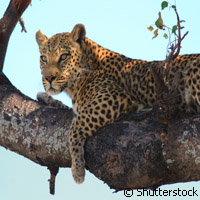How the leopard got his spots... was Kipling right?
In his 'Just So' stories, Rudyard Kipling explains that the leopard owes its distinctive rosette-like markings to a move to a 'great forest, 'sclusively full of trees and bushes and stripy, speckly, patchy-blatchy shadows'. Now new research from the University of Bristol in the UK reveals that Kipling wasn't far wrong - species of cat that dwell in forests, spend a lot of time in trees and hunt at night tend to have patterned coats while species living in more open environments are more likely to sport a relatively plain coat. The findings, published in the Proceedings of the Royal Society B journal, suggest that cats' coats serve primarily as camouflage. The study also offers an explanation as to why black leopards are fairly common but black cheetahs are unheard of. Cat species have extremely diverse markings; some, like lions, are fairly plain, while others have coats covered in spots, rosettes and stripes of varying degrees of complexity and irregularity. In a bid to determine the driving forces behind this diversity, the researchers carefully classified the markings of 35 species of cat from around the world and linked them to a mathematical model of pattern development. The study reveals that plain cats are usually found in open environments that are uniform in colour, texture and light levels. In contrast, patterned cats tend to live in woodland, where the trees cast Kipling's 'stripy, speckly, patchy-blatchy shadows'. The most irregular patterns are found on cats that hunt at night, live in tropical forests, and spend much of their lives up trees. 'It is also likely that the particular pattern generally evolves to resemble the size, shape and variability of pattern elements in the background,' the researchers speculate. The scientists note that these findings support the idea that cats' markings serve as an effective camouflage. Anyone with a pet cat will know that cats hunt by creeping up on their prey stealthily before pouncing when they are very close. A good camouflage is essential to the success of this strategy. In addition, a good camouflage may protect smaller species of cat from predators. One interesting outcome from the study concerns tigers, the only cats in the study to feature vertical stripes. This unusual pattern is not linked to a grassland habitat; as the researchers point out, tigers are not 'strongly associated' with this habitat. Nevertheless, tigers are extremely well camouflaged, causing the researchers to wonder why vertical stripes are not more common in cats and other mammals. The study also sheds light on the question of why some cat species (like the leopard) often feature black creatures, while others (like the cheetah) do not. Unlike cheetahs, leopards live in a wide range of habitats and have varied behavioural patterns, the researchers explain. This diversity means that different individuals can exploit different ecological niches, allowing unusual colours or patterns to become established in the population. There are some exceptions to the trends; the cheetah lives in the open grasslands yet is spotted, and the plain flat-headed cat inhabits more closed environments. According to the researchers, these anomalies should be investigated further.
Countries
United Kingdom



